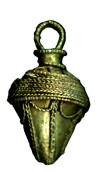About the burial-free kurgans once again
DOI:
https://doi.org/10.23858/SA69.2017.018Słowa kluczowe:
burial mounds, Kashubian Lake District, Pomeranian culture, Early Iron AgeAbstrakt
One of the features of the burial mound necropolises of Pomeranian culture in the Kashubian Lake District is the presence, beside the mounds, of burial-free constructions. Their form resembles burial mounds or kurgans and their function can often raise questions. This may sometimes result from the fact that such structures are formed in distinct clusters in the cemeteries. At the current stage of research, it can be hypothesized that theyrepresent an integral part of the necropolis.
Pobrania
Bibliografia
Dąbrowski J. 1987. Die Lausitzer Kultur und der Nordische Kreis. In. E. Plesl and J. Hrala (eds.), Die Urnenfelderkulturen Mitteleuropas. Syposium Liblice 21.-25.10.1985. Praha: Archäologisches Institut der Tschechoslowakischen Akademie der Wissenschaften, 71-78.
Fahlander F. and Oestigaard T. 2008. The Materiality of Death. Bodies, Burials, Beliefs. In F. Fahlander and T. Oestigaard (eds.), The Materiality of Death. Bodies, Burials, Beliefs (= British Archaeological Reports. International Series 1768). Oxford: Archaeopress, 1-16.
Häringe Frisber K. 2005. Where are the Dead? Empty Graves from early Iron Age Uppland. In T. Artelius and F. Svanberg (eds.), Dealing with the Dead. Archaeological Perspectives on Prehistoric Scandinavian Burial Ritual. Stockholm: National Heritage Board, 143-158.
Janiak R. 2011. Rezultaty badań wykopaliskowych przeprowadzonych w 2009 roku na cmentarzysku kurhanowym w Mściszewicach, gm. Sulęczyno, stanowisko 3. In M. Fudziński and H. Paner (eds.), XVII Sesja Pomorzoznawcza 1. Od epoki kamienia do wczesnego średniowiecza. Gdańsk: Muzeum Archeologiczne w Gdańsku, 149-158.
Janiak R. 2012. Kamienna konstrukcja w kształcie łodzi na cmentarzysku kurhanowym w Nowej Sikorskiej Hucie, stan. 2, pow. Kartuzy. In W. Blajer (ed.), Peregrinationes Archaeologicae in Asia et Europa Joanni Chochorowski dedicatae. Kraków: Instytut Archeologii Uniwersytetu Jagiellońskiego, Wydawnictwo Archeo-Profi l, 65-70.
Janiak R. 2014. Kurhany z młodszych okresów epoki brązu i wczesnej epoki żelaza na Pojezierzu Kaszubskim. Łódź: Instytut Archeologii Uniwersytetu Łódzkiego, Fundacja Uniwersytetu Łódzkiego.
Janiak R. 2016. Uwagi o bezpochówkowych kurhanach kultury pomorskiej na obszarze Pojezierza Kaszubskiego. Zeszyty Wiejskie 22, 829-837.
Kalaga J. 2006. Ciałopalny obrządek pogrzebowy w międzyrzeczu Liwca, Bugu i Krzny we wczesnym średniowieczu. Warszawa: Instytut Archeologii Uniwersytetu Warszawskiego.
Kaliff A. 2001. Gothic Connections. Contacts between eastern Scandinavia and the southern Baltic coast 1000 BC – 500 AD. Uppsala: Department of Archaeology and Ancient History, Uppsala University.
Kaliff A. 2005. The Vedic Agni and Scandinavian Fire Rituals. A Possible Connection. Current Swedish Archaeology 13, 77-97.
Kaliff A. and Oestigaard T. 2004. Cultivating Corpses. A Comparative Approach to Disembodied Mortuary Remains. Current Swedish Archaeology 12, 83-104.
Mikulski K. 1994. Osadnictwo wiejskie województwa pomorskiego od połowy XVI do końca XVII wieku. Toruń: Towarzystwo Naukowe w Toruniu.
Ossowski G. 1878. O pomnikach przedhistorycznych Prus Królewskich. Rocznik Towarzystwa Naukowego w Toruniu, 15-46.
Ossowski G. 1881. Mapa archeologiczna Prus Zachodnich (dawniej Królewskich) z przyległymi częściami W. Ks. Poznańskiego. Kraków.
Rzepecki S. 2016. From Potatoes to Barrows, or there and back again. Sprawozdania Archeologiczne 68, 409-419.
Sabatini S. 2007. House urns. A European Late Bronze Age Trans-cultural Phenomenon. Göteborg: Göteborgs Universitet.
Sabatini S. 2014. Burial practices as imagined community spaces: the example of the Late Bronze Age house urns. In H. Alexandersson, A. Andreeff and A. Bünz (eds.), Med hjärna och hjärta: En vänbok till professor Elisabeth Arwill-Nordbladh. Göteborg: University of Gothenburg, 537-549.
Szymańska A. 1977. Cmentarzysko kurhanowe kultury łużyckiej z IV-V okresu epoki brązu w Siemirowicach, gm. Cewice (badania w latach 1971-1974). Pomorania Antiqua 7, 247-341.
Tuszyńska M. 1984. Cmentarzysko z okresu halsztackiego w Mściszewicach, gm. Sulęczyno, stanowisko 5. In M. Haftka, M. Kwapiński and M. Kochanowski (eds.), IX Sesja Pomorzoznawcza. Gdańsk, 22-23.III.1984 r. Materialy. Gdańsk: Polskie Towarzystwo Archeologiczne i Numizmatyczne Oddział w Gdańsku, Muzeum Archeologiczne w Gdańsku, 44-49.
Wangen V. 2009. Gravfeltet på Gunnarstorp i Sarpsborg, Østfold. Et monument over dødsriter og kultutøvelse i yngere bronsealder og eldste jernalder. Oslo: Kulturhistirisk Museum, Universitetet I Oslo.














